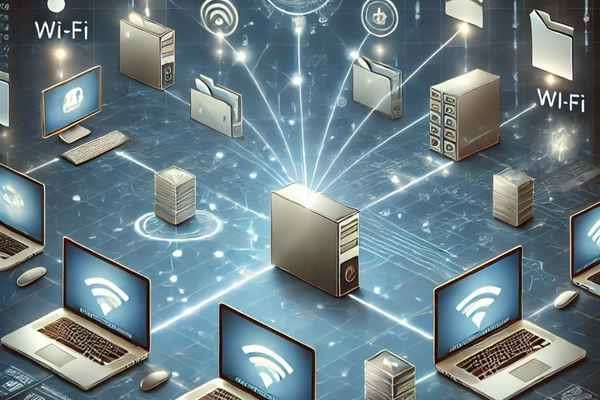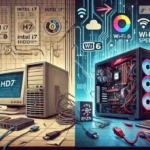In today’s digital age, the ability to share resources across multiple devices is not just a convenience; it’s a necessity. Whether in a home, a business, or a public environment, network sharing allows us to connect computers and devices to communicate and share data efficiently. This blog post will delve into the mechanics of network sharing, exploring how it works, its benefits, and its applications.
What is Network Sharing?
Network sharing is the process of making resources such as files, printers, and internet connections accessible to multiple users or devices within a networks. This can be achieved through wired or wireless connections, enabling devices to communicate and collaborate seamlessly.
Types of Network Sharing
1. File Sharing: This allows users to share documents, images, videos, and other files between computers. It can be achieved through shared folders on a local network or through cloud services.
2. Printer Sharing: With printer sharing, multiple devices can use a single printer, reducing the need for multiple printing devices and cutting costs.
3. Internet Connection Sharing: This allows multiple devices to access the internet through a single connection, often managed by a router or a hotspot.
4. Peripheral Sharing: Devices such as scanners and external drives can be shared across a network, providing access to multiple users without needing physical connections.
How Does Network Sharing Work?
Network sharing relies on several components and protocols to function effectively. Here’s a look at how these elements come together to enable seamless sharing:
Network Components
1. Routers and Switches: These devices direct data packets between computers and other devices within a network. Routers connect networks to the internet, while switches connect devices within a network.
2. Network Interface Cards (NICs): Every device on a network requires a NIC to connect. It can be built-in or an external USB adapter, allowing the device to communicate over the network.
3. Cables and Wireless Signals: Wired networks use Ethernet cables, while wireless networks rely on Wi-Fi signals. Both methods transmit data between devices.
Network Protocols
1. TCP/IP (Transmission Control Protocol/Internet Protocol): This is the fundamental suite of protocols that allows different network devices to communicate. It ensures data is sent and received correctly.
2. SMB (Server Message Block): Used primarily for file sharing, SMB allows applications to read and write to files and request services from server programs on a network.
3. NFS (Network File System): Commonly used in Unix and Linux systems, NFS enables users to access files over a network as easily as if they were on their local devices.
4. HTTP/HTTPS (Hypertext Transfer Protocol/Secure): These protocols are used for accessing web-based resources, ensuring data is shared securely over the internet.
Benefits of Network Sharing
Network sharing offers numerous advantages, making it an integral part of modern computing:
1. Cost Efficiency: By sharing resources like printers and internet connections, organizations can reduce hardware costs and minimize maintenance.
2. Convenience: Users can access shared files and resources from any connected device, enhancing productivity and collaboration.
3. Scalability: Networks can be easily expanded to accommodate more devices, making it simple to scale operations as needed.
4. Centralized Management: Network sharing allows for centralized control, making it easier to manage security settings, user access, and resource allocation.
5. Improved Communication: Enhanced connectivity fosters better communication between users, whether they are in the same building or across the globe.
Applications of Network Sharing
Network sharing is applied in various settings, from small home networks to large corporate environments:
Home Networks
In homes, network sharing enables family members to connect multiple devices to the internet, share media files, and access shared printers. Home automation systems also benefit from network sharing, allowing smart devices to communicate with each other.
Business Networks
Businesses rely heavily on network sharing to improve operational efficiency. Employees can collaborate on projects, access centralized databases, and utilize shared office equipment, all of which contribute to a more streamlined workflow.
Educational Institutions
Schools and universities use networks sharing to provide students and staff with access to educational resources and research databases. It also facilitates online learning platforms and virtual classrooms.
Public Networks
Public spaces like libraries, airports, and coffee shops offer networks sharing to provide internet access to patrons, enhancing customer experience and satisfaction.
Challenges in Network Sharing
While networks sharing offers many benefits, it also presents challenges that need to be addressed:
1. Security Risks: Sharing networks can expose sensitive data to unauthorized access if not properly secured. Employing encryption, firewalls, and secure passwords can mitigate these risks.
2. Bandwidth Limitations: With multiple devices sharing a single connection, bandwidth can become a bottleneck, affecting performance. Quality of Service (QoS) settings can help prioritize traffic to ensure critical applications receive adequate bandwidth.
3. Compatibility Issues: Different devices and operating systems may have compatibility issues that can hinder networks sharing. Using standardized protocols and regularly updating software can alleviate these problems.
Conclusion
Networks sharing is a cornerstone of modern connectivity, enabling efficient resource utilization and fostering collaboration across various environments. By understanding the mechanics of network sharing, users and organizations can harness its full potential while addressing the associated challenges. In a world that is increasingly interconnected, mastering networks sharing is essential for staying ahead in the digital landscape.


